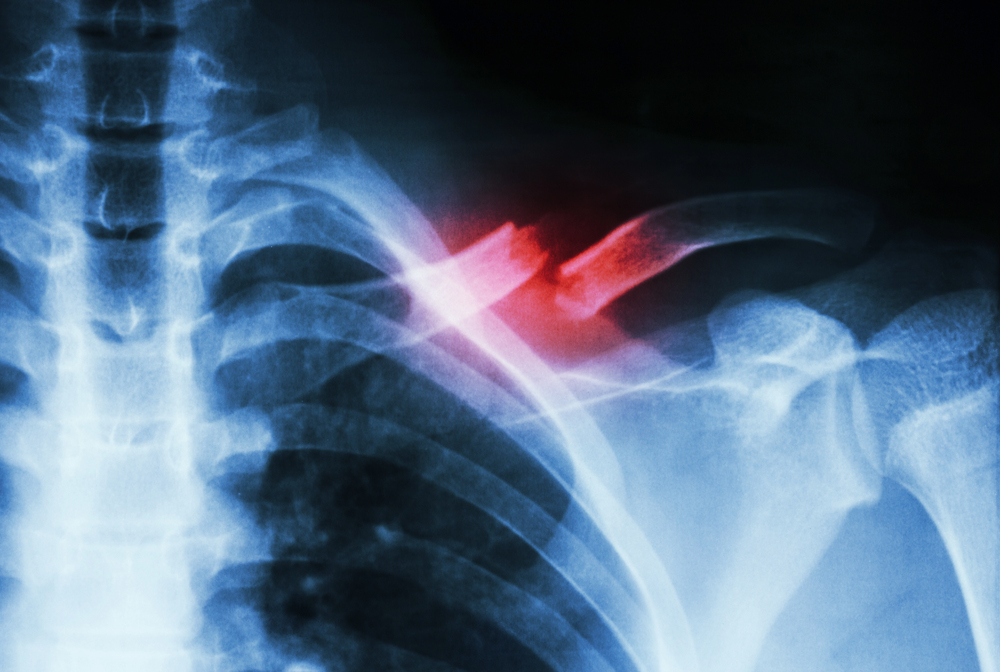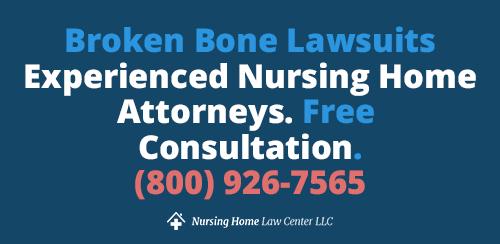The Nursing Home Law Center is committed to providing the legal resources necessary to hold negligent facilities accountable.
Nursing Home Bone Fracture Lawyer
Helping Elderly Patients Recover Compensation for Broken Bones
At Nursing Home Law Center, we are committed to protecting the rights and dignity of nursing home residents who have suffered abuse and neglect, including severe injuries such as bone fractures, hip fractures, and traumatic falls.
Our nursing home bone fracture attorneys have successfully obtained substantial settlements for elderly patients harmed by nursing home negligence, such as:
- A $735,000 settlement for a nursing home patient who suffered a broken leg and multiple compression fractures in her lumbar and cervical spine after falling from a wheelchair left unattended
- A $1,700,000 settlement on behalf of a resident who endured a serious hip fracture and subdural hematoma resulting from a preventable fall at a nursing facility.
If your loved one has experienced broken bones, unexplained fractures, or any form of elder abuse or neglect at an assisted living facility or nursing home, we offer a free case evaluation to discuss your legal options and ensure residents’ safety and justice.

Causes of Fractures Among Elderly Nursing Home Residents
Several medical risk factors increase the likelihood of fractures among senior citizens:
- Osteoporosis causes bones to weaken, making them more prone to breaking from even minor falls.
- Mobility issues requiring the use of canes, walkers, or wheelchairs can increase fall risks.
- Muscle weakness affects balance and coordination, leading to dangerous falls.
- Certain medications, including sedatives and tranquilizers, may cause dizziness or impair stability.
When nursing home staff members don’t correctly staff enough employees, residents may be left unsupervised, increasing the risk of falls and unexplained fractures.
Nursing Home Fracture Statistics
- Approximately 50–75% of nursing home patients experience a fall each year.
- Around 20% of falls result in serious injuries. Fractures account for 2-6%.
- Following an initial hip fracture, research indicates that approximately 6% of residents sustain another fracture within six months, with this figure rising to about 12% within one year, and climbing further to roughly 21% within five years.
- Mortality rates following a hip fracture in nursing home residents are notably high: around 23% pass away within six months, 31% within one year, and approximately 60% within five years.

Types of Fractures in Nursing Homes
Bone fractures in elderly patients can vary significantly, depending on the location, cause, and severity of the injury.
Compression fractures involve small breaks or cracks in the vertebrae, typically due to osteoporosis or weakened bones. Common among elderly residents with brittle bones or those suffering from chronic bone-density loss, these injuries can occur with minimal stress, such as a minor fall, bending, or even a forceful cough.
Also known as hairline fractures, stress fractures are tiny cracks in bones resulting from repetitive motion or continuous pressure. They most frequently affect the lower legs, ankles, and feet. Often subtle, stress fractures can go unnoticed without timely intervention, potentially worsening into more serious injuries.
Traumatic fractures result from significant external force or trauma, such as falls, collisions, or physical abuse within care facilities. These fractures frequently affect the hips, pelvis, wrists, arms, and femur. A traumatic fracture can indicate serious underlying issues like lack of proper supervision, failure to implement fall prevention measures, or unsafe environmental conditions.
Hip fractures are among the most severe and life-threatening injuries for older adults residing in nursing facilities. Usually caused by falls, they drastically impact mobility and quality of life.
Other common fractures sustained by elderly residents in care facilities include:
- Pelvic fractures
- Femur (thigh bone) fractures
- Fractured vertebrae and spinal injuries
- Ankle and wrist fractures
- Arm fractures
- Skull and facial fractures
Nursing Homes’ Duty to Prevent Fractures
Under federal law, nursing homes are required to protect residents from preventable injuries, including fractures.
Specifically, 42 CFR §483.25(d) states that facilities participating in Medicare and Medicaid must ensure residents receive appropriate supervision, adequate assistance devices, and comprehensive care to prevent accidents and harm.
The CMS State Operations Manual – Appendix PP mandates that nursing facilities maintain safe, hazard-free environments, conduct ongoing resident assessments, and implement personalized care plans.
42 CFR §483.35 mandates consistent and adequate staffing to ensure ongoing supervision and timely assistance for mobility and transfers, significantly reducing the likelihood of fractures.
All nursing homes must develop and execute clear and detailed programs to prevent falls that include:
- Individualized risk assessments, updated regularly to reflect each resident’s evolving condition and needs.
- Safe facility design, including proper lighting, clutter-free walkways, secure flooring, and accessible handrails and grab bars in bathrooms and high-risk areas.
- Routine staff training to ensure employees understand proper safety protocols, mobility assistance methods, and effective emergency response procedures.
Unexplained Fractures as a Sign of Nursing Home Abuse and Neglect
Unexplained fractures are frequently indicators of abuse or neglect in nursing homes. Common causes of neglect in nursing facilities linked to unexplained broken bones include:
- Understaffing or poorly trained staff who fail to provide appropriate resident supervision and assistance.
- Failure to properly monitor and assist residents with mobility, transfers, and daily activities.
- Improper use or maintenance of mobility equipment, such as wheelchairs, walkers, or transfer lifts.
- Delays in providing medical care and assessment
Signs of Abuse in Nursing Homes
Fractures are not always immediately obvious, especially when they involve hairline or stress fractures. Common signs of bone fractures among residents in nursing home facilities include:
- Pain, swelling, or tenderness around the affected area
- Visible deformity or misalignment of the limb
- Bruising, discoloration, or unusual skin markings
- Reduced range of motion or limited mobility
- Difficulty or inability to bear weight or stand
Reporting Nursing Home Negligence and Abuse Leading to Broken Bones
If your loved one has suffered broken bones due to suspected nursing home neglect or abuse, swift action is essential. Below are key resources you should reach out to, depending on your specific situation:
- Immediately contact local law enforcement if you suspect criminal actions, such as assault or intentional harm leading to broken bones. They will quickly investigate and intervene.
- Adult Protective Services (APS) investigates elder abuse, neglect, and exploitation by caregivers and coordinates with other agencies when needed.
- State Long-Term Care Ombudsmen advocate specifically for nursing home residents. They assist with complaints, investigate concerns, and escalate serious cases involving neglect or injury.
- Your State’s Department of Health or Licensing & Certification Division handles violations of state or federal nursing home regulations, such as understaffing or safety hazards leading to injuries.
- If the nursing home receives Medicare or Medicaid funding, the Centers for Medicare & Medicaid Services (CMS) oversees and investigates complaints involving serious neglect or abuse.
- Consider consulting an experienced nursing home abuse attorney if you’re exploring a civil lawsuit to seek justice and compensation for injuries related to neglect or abuse.

Nursing Home Fracture FAQs
What are common bone fracture complications?
Common complications from bone fractures include infections, chronic pain, limited mobility, nerve and blood vessel damage, blood clots, pressure sores, muscle weakness, and pneumonia—particularly among elderly nursing home residents. Serious fractures, like hip fractures, can also significantly increase mortality risk.
Can you get sepsis from a broken bone?
Yes, sepsis can develop from a broken bone if an infection occurs. Open fractures, surgical procedures, or untreated infections increase this risk. Sepsis is life-threatening and requires immediate medical intervention.
How long does it take for a broken bone to heal in older adults?
Healing times for older adults vary based on fracture type, location, and overall health, but typically range from 6–12 weeks or longer. Due to age-related factors like osteoporosis and poor circulation, older adults may heal more slowly or experience incomplete healing, potentially requiring extended medical care and rehabilitation.
How long does it take to resolve a case against a nursing home?
Resolving a nursing home abuse or neglect case can take anywhere from several months to two years or more, depending on the complexity, available evidence, willingness to negotiate a settlement, and court schedules. Cases involving severe injuries or wrongful death typically require more time.
Do I need a broken bone injury lawyer to file a claim?
Legally, you can file a bone fracture claim without a personal injury lawyer, but nursing home abuse cases are complex and challenging to navigate alone. Hiring an experienced fracture injury attorney significantly improves your chances of a successful outcome by ensuring all deadlines are met, evidence is properly gathered, and your rights are protected.
How much does it cost to hire a fracture injury lawyer?
The bone fracture injury lawyers at Nursing Home Law Center work on a contingency fee basis, meaning you pay no upfront fees. We only get paid if we successfully obtain compensation for you.
Can I file a lawsuit if my loved one died after a broken bone injury in a nursing home?
Yes, you can potentially file a wrongful death lawsuit if your loved one died following a fracture caused by abuse or neglect in a nursing home. Surviving family members or the estate may recover compensation for medical costs, pain and suffering, funeral expenses, and other damages related to the loss.
How much compensation can I recover in a personal injury lawsuit?
The compensation you may recover in a broken bone claim varies significantly based on injury severity, medical expenses, pain and suffering, emotional distress, and potential punitive damages. Settlements and verdicts commonly range from tens of thousands to hundreds of thousands of dollars or more, with particularly egregious cases reaching over a million dollars.
Who is liable for a nursing home fracture injury?
The nursing home facility itself is usually liable for fractures resulting from abuse or neglect. Liability may extend to individual staff members, administrators, owners, or third-party providers responsible for resident care, depending on the circumstances of the injury and the contributing factors.
Book a Free Consultation With a Nursing Home Abuse Lawyer!
Broken bones in elderly nursing home residents can cause severe complications, including long-term disability, chronic pain, loss of independence, and even death. These injuries often lead to substantial medical expenses, emotional distress, and diminished quality of life for both residents and their families.
When nursing facilities fail to provide adequate supervision or implement proper safety measures, they should be held accountable. Victims and their families may be entitled to significant compensation for their losses and suffering.
At the Nursing Home Law Center, our experienced nursing home abuse lawyers specialize in cases involving fractures and injuries resulting from neglect or abuse. Our broken bone injury law firm offers free consultations to help residents and families understand their rights and legal options.
Contact a broken bone injury attorney today at (800) 926-7565 or fill out our online form.
Common Nursing Home Injuries

